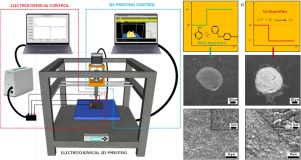Applied Materials Today ( IF 8.3 ) Pub Date : 2019-12-23 , DOI: 10.1016/j.apmt.2019.100530 Adriano Ambrosi , Richard D. Webster , Martin Pumera

|
Major efforts for the advancement of additive manufacturing are lately focused on the development of multi-material 3D-printing (mMat-3DP) methods which can enable the fabrication of complete devices in a single printing process combining materials with different properties (structural, functional, conductive, etc.). Printing conductive (metal and non-metal) materials with low-energy-consuming and economical methods is of particular interest since it would facilitate the production of electrodes, catalytic surfaces and electronic circuitry in general for countless applications. In order to contribute to the future vision of mMat-3DP, we wish to show here an economical method to selectively deposit different conductive materials (metal and conductive polymer) by means of electrochemical driving forces. A custom-made electrochemical liquid dispenser with embedded electrodes is used to electrodeposit selectively a metal (Cu), a conductive polymer (polyaniline), or a combination of the two, with both precursors present simultaneously and conveniently in the common electrolytic bath. Combining the 3D-patterning ability of a desktop 3D-printer with a concurrent control of the electrochemical process, selective deposition is demonstrated over a conductive graphite foil used as the cathode. Printing and electrochemical parameters have been optimized using scanning electron microscopy and energy dispersive X-ray spectroscopy to characterize the printed structures. The electrochemical 3D-printing method, being inherently low-cost, scalable and compatible with electrode fabrication methods shall find a broad scope of applications.
中文翻译:

电化学驱动的多材料3D打印
增材制造发展的主要努力最近集中在多材料3D打印(mMat-3DP)方法的开发上,该方法可以在单一打印过程中制造出具有不同特性(结构,功能,导电等)。使用低能耗且经济的方法来印刷导电(金属和非金属)材料尤为重要,因为它通常可促进无数应用的电极,催化表面和电子电路的生产。为了促进mMat-3DP的未来发展,我们希望在此展示一种经济的方法,以通过电化学驱动力选择性沉积不同的导电材料(金属和导电聚合物)。具有嵌入式电极的定制电化学液体分配器用于选择性地电沉积金属(Cu),导电聚合物(聚苯胺)或两者的组合,两种前体同时并方便地存在于普通电解槽中。将台式3D打印机的3D图案化能力与电化学过程的同时控制相结合,在用作阴极的导电石墨箔上展示了选择性沉积。印刷和电化学参数已使用扫描电子显微镜和能量色散X射线光谱法进行了优化,以表征印刷结构。固有的低成本,可扩展且与电极制造方法兼容的电化学3D打印方法将找到广泛的应用范围。


























 京公网安备 11010802027423号
京公网安备 11010802027423号